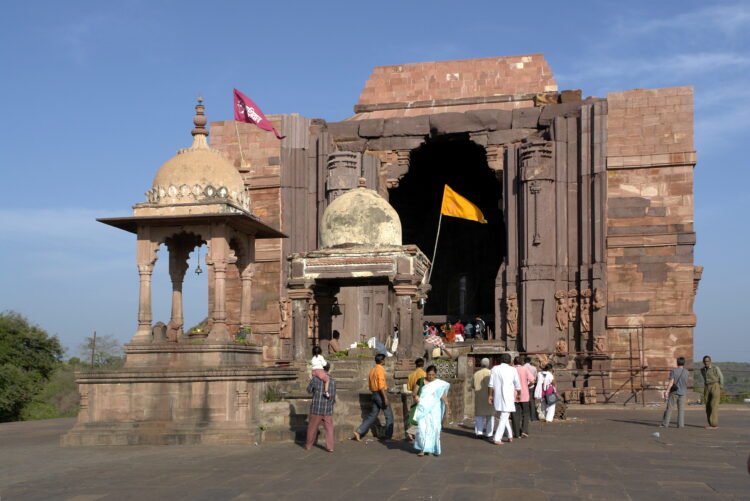No products in the cart.
A Heritage of Great Hindu Civilisation Bhimbetka & Bhojpur
A World Heritage Site at Heart of the Incredible India Madhya Pradesh - Best time to explore July to March.
BHIMBETKA
A World Heritage Site
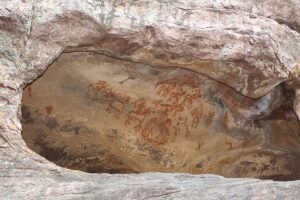
Surrounded by the northern fringe of the Vindhyan ranges, Bhimbetka lies 46 km south of Bhopal. In this rocky terrain of dense forest and craggy cliffs, over 600 rock shelters belonging to the Neolithic age were recently discovered. Here, in vivid, panoramic detail, paintings in over 500 caves depict the life of the prehistoric cave-dwellers, making the Bhimbetka group an archaeological treasure, an invaluable chronicle in the history of man. Executed mainly in red and white with the occasional use of green and yellow, with themes taken from the every day events of aeons ago, the scenes usually depict hunting, dancing, music, horse and elephant riders, animals fighting, honey collection, decoration of bodies, disguises, masking and household scenes. Animals such as bisons, tigers, lions, wild boars, elephants, antelopes, dogs, lizards, crocodiles etc. have been abundantly depicted in some caves. Popular religious and ritual symbols also occur frequently.
The superimposition of paintings shows that the same canvas was used by different people at different times. The drawings and paintings can be classified under seven different periods:
Period I- (Upper Paleolithic): These are linear representations, in green and dark red, of huge figures of animals such as bisons, tigers, and rhinoceroses.
Period II (Mesolithic): Comparatively small in size, the stylised figures in this group show linear decoration on the body. In addition to animals, there are human figures and hunting scenes, giving a clear picture of the weapons they used: barbed spears, pointed sticks, bows and arrows. The depiction of communal dances, birds, musical instruments, mother and child, pregnant women, men carrying dead animals, drinking and burials appear in rhythmic movement.
Period III – (Chalcolithic): Similar to the paintings of Chalcolithic pottery, these drawings reveal that during the period the cave dwellers of this area had come in contact with the agricultural communities of the Malwa plains and started an exchange of their requirements with each other.
The colours of the paintings have remained intact for many centuries Period IV & V – (Early Historic): The figures of this group have a schematic and decorative style, and are painted mainly in red, white and yellow. The association is of riders, depiction of religious symbols, tunic-like dresses and the existence of scripts of different periods. The religious beliefs are represented by figures of yakshas, tree gods and magical sky chariots.
Period VI & VII – (Medieval): These paintings are geometric, linear and more schematic, but they show degeneration and crudeness in their artistic style.
The colours used by the cave dwellers were prepared combining manganese, haematite, soft red stone and wooden coal. Sometimes the fat of animals and extracts of leaves were also used in the mixture. The colours have remained intact for many centuries due to the chemical reaction resulting from the oxide present on the surface of the rocks.
Lakhajwar & S-Belt Paintings belonging to upper paleolithic period to Medieval period are also seen in the surrounding areas of Bhimbetka.
BHOJPUR
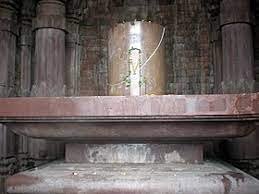
Founded by the legendary Parmar king of Dhar, Raja Bhoj (1010-’53), and named after him, Bhojpur, 28 km from Bhopal, is renowned for the remains of its magnificent Shiva Temple and Cyclopean dam.
The temple, which has earned the nomenclature of the Somnath of the East, is known as the Bhojeshwar Temple. In plan a simple square with an exterior dimension of 66 feet, devoid of the re-entrant angles are usual in such buildings. The richly carved dome, though incomplete, has a magnificent, soaring strength of line and is supported by four pillars. These, like the dome, have been conceived on a massive scale, yet retain a remarkable elegance because of their tapering form. Divided into three sections, the lowest is an octagon with facets of 2.12 feet, from which springs a 24-faced section.
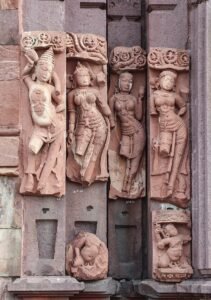
Richly carved above, the doorway is plain below, throwing into sharp relief the two exquisitely sculpted figures that stand on either side. On the other three Bhojeshwar Temple, Bhojpur is known as the Somnath of the East sides of the structure are balconies, each supported by massive brackets and four intricately carved pillars. The lingam in the sanctum rises to an awe-inspiring height of 7.5 feet with a circumference of 17.8 feet. Set upon a massive platform 21.5 feet square, and composed of three superimposed limestone blocks, the architectural harmony of lingam and platform creates a superb synthesis of solidity and lightness.
The temple was never completed, and the earthern ramp used to raise it to dome-level still stands. Had it been completed, it would have had very few rivals. As it is, even with the ravages of time, it remains one of the best examples of temple architecture of the 12th and 13th centuries.
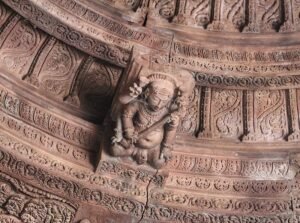
Also incomplete, and with a similar stone-raising ramp, is a Jain shrine that stands close to the Bhojeshwar temple. Three figures of the tirthankaras are contained within, one being a colossal statue of Mahavira 20 feet high, and the other two of Parsvanath. Rectangular in plan, this temple probably belongs to the same period as the Bhojeshwar.
West of Bhojpur once lay a vast lake, but nothing remains except the ruins of the magnificent old dams by which its waters were contained. The site was chosen with great skill, as a natural wall of hills enclosed the whole area except for two gaps, 100 yards and 500 yards in width respectively. These were closed by gigantic earthern dams, faced on both sides with enormous blocks of sandstone, many being 4 feet long, 3 feet broad and 2.5 feet thick, set without mortar. The smaller dam is 44 feet high and 300 feet thick at the base, the larger dam 24 feet high with a flat top 100 feet broad. These embankments held up an expanse of water of about 250 square miles. This great work is ascribed to Raja Bhoj, but it may possibly be of an earlier date.
The lake was destroyed by Hoshang Shah of Malwa (1405-34), who cut through the lesser dam, and thus, either intentionally or in a fit of destructive passion, added an enormous area of the highest fertility to his possessions. According to a Gond legend, it took an army of them three months to cut through the dam, and the lake took three years to empty, while its bed was not habitable for thirty years afterwards. The climate of Malwa is said to have been considerably altered by the removal of this vast sheet of water
Ashapuri: It is near Bhojpur at a distance of 40Kms. The ruins here indicate that a large group of temples existed here on the bank of a large pond, the remains of which are still visible. Presently, the remnants of temples (the Ashadevi temple, the Bhootnath temple, the Bilauta temple and Satmasia temple) can be seen.
Access
By Air: Bhopal (28 km from Bhojpur, and 46 km from Bhimbetka) is the nearest airport.
By Rail: Bhopal, on the Delhi-Chennai and Delhi-Mumbai mainline is the most convenient rail-head.
By Bus: Both Bhojpur and Bhimbetka are connected by bus with Bhopal.


